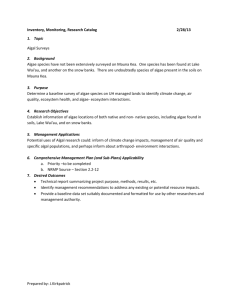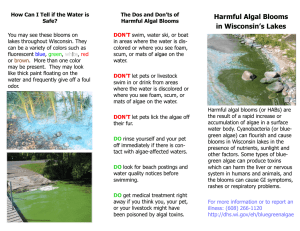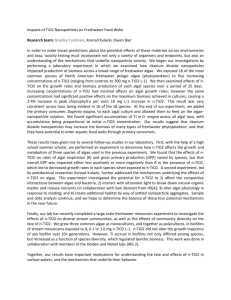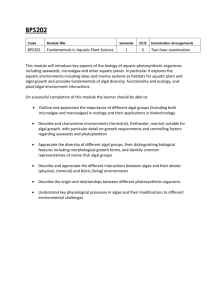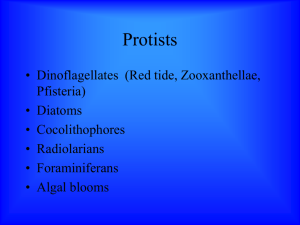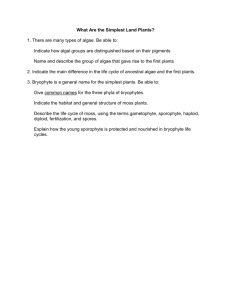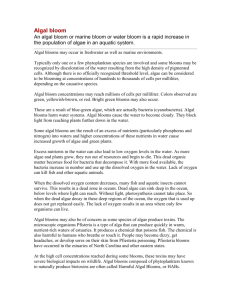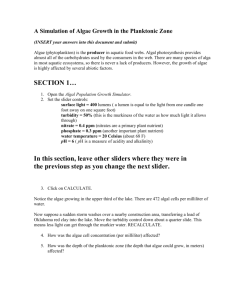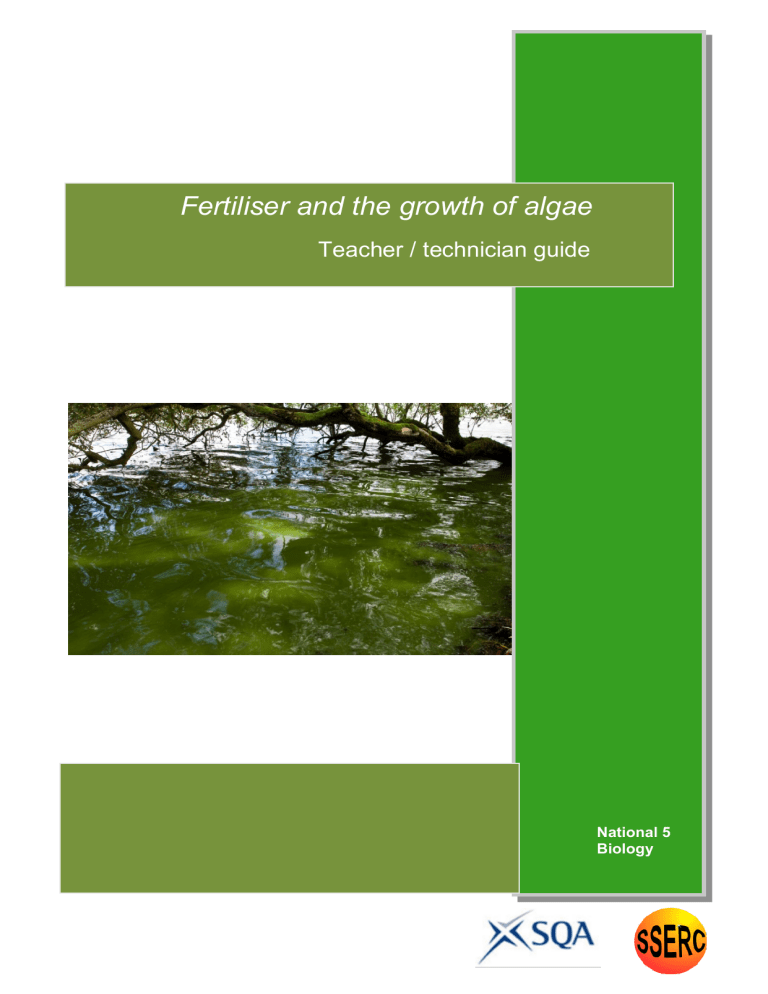
Fertiliser and the growth of algae Teacher / technician guide National 5 Biology 1 National 5 Biology Fertiliser and the growth of algae Teacher / Technician Guide This activity can be used to: • • provide evidence for the assignment at National 5 provide an opportunity to study the relationship between unwanted nitrates from, for example fertiliser, and the growth of algal population in waterways Curriculum links Life on Earth Mandatory Knowledge Depth of knowledge required / Teaching notes Suggested activities 5. Food production c. Fertilisers can leach into fresh water, adding extra, unwanted nitrates. This will increase algal populations which can cause algal blooms. Algal blooms reduce light levels, killing aquatic plants. These dead plants, as well as dead algae, become food for bacteria which increase greatly in number. The bacteria use up large quantities of oxygen, reducing the oxygen availability for other organisms. Investigate the effect of fertiliser concentration on algal growth. Background information Algal blooms can occur when there is a combination of warm water (which is still or slow moving) and a high concentration of nutrients from sources like sewage or fertiliser run-off from local fields. As well as looking and smelling unpleasant, algal blooms can cause health problems for those who come in direct contact with them. Cyanobacteria (blue-greens) in some blooms produce toxins which are dangerous to humans, animals and many of the organisms which live in the water. 2 The increase in nutrient concentration that leads to algal blooms is known as eutrophication. Eutrophication is a process that happens naturally in some ecosystems. Eutrophication can also be increased by human activity when, for example, fertilisers from fields are washed into rivers, streams and ponds. Generally fertilisers contain high levels of nitrogen, phosphorous and potassium and if these are washed by rain from fields into a waterway they will provide the additional nutrients which can lead to an increase in algal and plant populations. Warm weather exacerbates the problem by further promoting the growth of these populations. The organisms which make up algal blooms that form in high nutrient conditions live for only a short time resulting in large quantities of dead and decaying organic matter. The decay process involves rapid growth of bacteria which use up dissolved oxygen in the process of respiration. Levels of dissolved oxygen in the waterways are thus severely reduced and, being deprived of oxygen, fish and other organisms die. The following practical activites, using house plant fertiliser, can serve as a model to represent algal blooms in a large body of water. This practical activity is based on an investigation which is outlined in, Algae: a practical resource for secondary schools (Society for General Microbiology, 2012). Algae are grown in distilled water and in fertiliser solution. Students can compare the size of the algal populations over time by measuring absorbance of the algal cultures using a colorimeter. A suggested supplementary activity is to observe the cultures directly using a microscope. The ‘hanging drop’ method is a cheaper alternative to using a cavity slide and coverslip. See the accompanying Hanging Drop Help Card. Some students might also compare algal growth over time by estimating population size by carrying out direct cell counts using a haemocytometer. Notes on the method The Student Activity Guide provides protocols for setting up and carrying out investigations into the growth of a population of freshwater algae. It is possible to use the basic method to investigate different variables: fertiliser concentration; fertiliser type. It would also be possible for different groups within the same class to carry out one of these investigations using different types of algae. See the Student Activity Guide The use of conical flasks, loosely stoppered with cotton wool, will reduce evaporation since the investigation is to proceed for 10 days – 14 days. • • Flasks should be left close to a light source. The lamp can be turned off at night, or left on constantly. Flasks should be swirled regularly. Absorbance is measured using a colorimeter set at 665 nm. In this case absorbance is a measure of the extent to which light is scattered by the cells in suspension. 3 • • • The ‘control cuvettes’ used for ‘blank’ colorimeter measurements should be retained and frozen in between measurements. This is to reduce bacterial contamination which might cloud the liquids. The cuvettes will need time to thaw each time prior to taking readings. It is possible that some students might estimate population size by carrying out cell counts directly using a haemocytometer. It would be good experimental practice to set up repeat experiments. Where this is not possible, student results may be shared. Materials for each group of pupils • • • • • • • • • • • • • • 50 cm3 measuring cylinder 4 x 250 cm3 conical flask Cotton wool 1 x 5 cm3 syringe Distilled water Suitable liquid plant fertiliser (x 3 if investigating fertiliser type) Access to a colorimeter 4 x cuvette for preparing ‘control cuvettes’ 4 x cuvette for each occasion on which colorimeter readings are taken 5 x 1 cm3 plastic pipette for setting up the cultures (x 7 if investigating fertiliser type) 4 x 1 cm3 plastic pipette for each occasion on which colorimeter readings are taken Access to a discard jar containing the appropriate concentration of VirkonTM Stock algae culture Marker pen Materials for preparing the hanging drop Using the hanging drop method for observing the algae under the microscope avoids the use of fragile coverslips and avoids the expense of cavity slides. This method will allow the students to observe the difference in size of the algal populations. See the Preparing a Hanging Drop help card. For each group of pupils • • • • • • Microscope Two glass microscope slides Lens tissue Pipette Blu-takTM Paper towels 4 Haemocytometer counts Instructions for counting cells using a haemocytometer can be found on the SSERC website. There are instructions for using a glass haemocytometer, or disposable plastic haemocytometer: http://www.sserc.org.uk/biology-resources/microbiological-techniques265/enumeratingmicro-organisms141 Notes on results • • Algal growth will not continue at its original rate over time because nutrients will eventually run out. Since algae require light energy in order to photosynthesise only a certain number of organisms can be sustained in a given space since light to some will be blocked out by other members of the population. Safety guidance In terms of Safety in Microbiology: A Code of Practice for Scottish Schools and Colleges (SSERC, 2012), working with algae as set out in the Student Activity Guide has little, if any, known risk; it is work at level 1. However, hands should be washed prior to and on completion of the activities involved in this practical work. Similarly, benches should be swabbed with 1% bleach prior to and on completion of the work. Discard jars containing the appropriate concentration of VirkonTM should be made available for sterilising used pipettes, cuvettes and microscope slides. Used algal cultures should be sterilised by autoclaving before they are discarded. Or, VirkonTM (an equal volume of 1% solution) can be added to cultures and left for 24 hours prior to disposal as liquid waste to the sink. http://www.sserc.org.uk/images/Publications/Biology/SSERCSafety_in_Microbiology_Code_of_Practice.pdf There is a generic risk assessment appended to this guide. Suitable algal cultures If students are going to use the hanging drop method of observing the algae populations, Euglena gracilis is a good species to use because the difference in the observed number of organisms over time is somehow more dramatic than that of non-motile species as the Euglena are seen swimming around. If students are going to carry out direct counts using a haemocytometer, non-motile species such as Chlorella vulgaris, or Scenedesmus quadricauda are appropriate to use. 5 Suppliers of algal cultures Algae Scientific and Chemical Euglena gracilis Blades Biological Sciento ✓ ✓ Chlorella vulgaris ✓ ✓ ✓ Scenedesmus quadricauda ✓ ✓ ✓ Timstar ✓ www.sciento.co.uk www.blades-bio.co.uk www.scichem.com www.timstar.co.uk Algae can be purchased along with algal growth media. In each case follow the supplier’s instructions for preparing a stock culture of algae. Possible websites for Fertilisers and the Growth of Algae activity http://www.odec.ca/projects/2013/beso13s/Results.html http://2014hs.igem.org/Team:UCL_Academy/Algae_Experiments http://www.chemeurope.com/en/whitepapers/126294/how-physics-discovered-toc.html http://www.sserc.org.uk/images/Biology/Higher_Biol/SQA/Production_Microorganisms_final.pdf http://www.bbc.co.uk/education/guides/ztb2pv4/revision/2 http://www.bbc.co.uk/schools/gcsebitesize/science/edexcel/problems_in_environment/pollutionre v4.shtml https://www.sciencedaily.com/terms/eutrophication.htm http://www.water-pollution.org.uk/eutrophication.html http://www.nature.com/scitable/knowledge/library/eutrophication-causes-consequences-andcontrols-in-aquatic-102364466 https://www.sciencedaily.com/terms/algal_bloom.htm http://2014.igem.org/wiki/images/8/80/Nitrate20graph-2.jpg 6 SSERC Risk Assessment 2 Pitreavie Court, South Pitreavie Business Park, Dunfermline KY11 8UU tel : 01383 626070 fax : 01383 842793 e-mail : sts@sserc.org.uk web : www.sserc.org.uk Step 1 Description of activity: Activity assessed Date of assessment Date of review (Step 5) School Department Step 2 Step 3 Fertiliser and the growth of algae Step4 List Significant of hazards here: of houseplant Who might liquid be harmed and onWhat are you of already What further action is Action by Action by Done Investigation the effect fertiliser the growth algal populations. how? doing? needed? whom? when? Contamination by unknown Students, teacher, Working with the guidance in Conical flasks are set up each containing AN algal culture together with varying concentrations of liquid fertiliser. Samples are taken at organisms in cultures The readings, Code of Practice: Safety in Microbiology regular intervals, over a periodtechnician of 10-14 days, for colorimeter haemocytometer counts orfor for preparing ‘hanging drops’. Scottish Schools and Colleges (SSERC, 2012) Additional comments: • Wash hands prior to and on completion of activities This is a generic risk assessment. Teachers should adapt it, if necessary, to theirprior owntosets • Swab benches andofoncircumstances. The risk assessments have been written completion of activities of used pipettes, syringes, assuming that the activities will be carried out as described in •theDispose accompanying pupil material and technician guides, in school science cuvettes discard jarstudents. containing laboratories with single-level, mainstream N5 classes comprising no moreto than 20 S4 VirkonTM • Dispose of used cultures by autoclaving, or adding VirkonTM for 24 hours prior to disposal as liquid waste to sink 7 8
